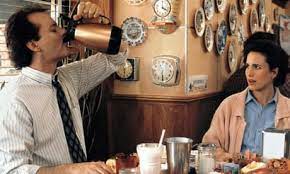Groundhog Day is a light comedy with plenty of deep insights about happiness, self-actualisation, growth and how to live a good life.
I recently watched the movie Groundhog Day for the umpteenth time. Once again, it made me realise it is an excellent allegory about self-actualisation, personal growth, and how to live (or not) a good life.
Groundhog Day is a light comedy, but it is also one of the most philosophical and deep movies you will find.
Rivers of ink have been spilt to write about the films’ philosophical and spiritual significance since it came out in 1993.
I rewatch it every couple of years, and it makes me think every time. I love that in a film, book, or any work of art.
It made me think again, so I thought I’d share my thoughts and reflections with you this time, dear reader. Hopefully, my musings make you think too.
Groundhog Day: The film
For the few of you who haven’t seen the movie yet (what are you waiting for?), please note that there are a few spoilers coming.
The film is about a TV weatherman called Phil Connor, played by Ray Murray, who, for some unexplained reason, is stuck in a time loop and wakes up every day on the same day and in the same place: 2nd of February, Groundhog Day, in Punxsutawney, Pennsylvania.
The focus of the story lies in Phil’s character arc and development.
He starts the movie as egotistic and cynical, and he ends up being compassionate, helpful, and wise. He passes through different phases: he is hedonistic and manipulative at first, then depressive and suicidal before his final breakthrough comes, and he realises the best thing he can do with his life is to learn new skills and help others.
Some people have calculated that Phil lived between thirty and forty years trapped on the same day. He didn’t age one bit, and he couldn’t be killed, even if he tried it many times. He remembered every day, but those around him didn’t, so every day was like starting anew.
In search of pleasure
This movie is a straightforward thought experiment, which is laid out in front of the viewer from the outset: how would you live your life if you were condemned (or blessed) to live the same day every day, and you didn’t age, nor die, and people wouldn’t remember the conversations you had with them when the day finished?
The protagonist first takes the easy route, the one many of us would have taken: the hedonist route. He gets drunk, eats in excess, enters a car chase with the police, robs a bank, and seduces the pretty girls in town by learning everything about them.
He uses his experience living the same day to satisfy his needs for instant pleasure.
Who wouldn’t? In another phase of my life, I certainly would.
Probably most of us have gone through phases in life where we equated happiness with pleasure, finally ending up disappointed and realising they are not the same thing.
Pleasure and happiness couldn’t be more different and far apart (more about it below).

Depression and rock bottom
After a while (months or years, who knows? It’s difficult to know exactly how much time passes in this movie), Phil realises that the search for pleasure is a never-ending race with no final ending and that the pleasure thrill has to be bigger and bigger to have an impact on him.
He also tries to seduce his colleague, Rita, played by Andy McDowell. Phil wants to believe he is in love with Rita but cannot really be in love with her when he is so centred on himself. He just wants to sleep with her, but she smells his lack of authenticity each time and refuses him with a slap on his face tens, probably hundreds of times before he finally gives up.
Phil doesn’t see any exit from his situation, and he cannot take this anymore.
He enters into a deep depression and tries to kill himself several times, but every time he wakes up in his hotel room at 6 am to start Groundhog Day once again. This is the saddest part of the movie but also brings out some of the funniest moments.
This will be the breakthrough moment for Phil.
As often happens in life, we need to touch rock bottom to realise what we need to do and have a clear breakthrough in our personal growth journey.
Self-actualisation and service to others
Phil will pull through and enter the phase of personal growth.
In his efforts to conquer Rita, Phil learns French and studies poetry. This makes him realise he might as well use his time more wisely, and he learns new skills. He learns how to play the piano and masters ice sculpting, among other things.
Phil finally starts his journey of self-actualisation and self-improvement.
He also starts helping others.
He starts with an old homeless man, who, despite all his efforts, dies in his arms every single day. Phil then realises he is not a god and cannot save him, but he can save others.
He uses all the knowledge he has amassed about each of the citizens of Punxsutawney and the events of the day to help them. He saves a kid from falling from a tree, a man from choking on his steak, changes the tire of some older women, and so on.
When he is a self-actualised man that is more focused on helping others than seeking his advancement or fleeting pleasure, is when Rita finally falls in love with him, and he reaches contentment and happiness in life.
This is the moment when the spell breaks, and he finally wakes up the next day, the 3rd of February.

Some learnings
This movie has plenty of learnings and valuable metaphors. We will focus on three here.
Pleasure vs happiness
We touched upon this above. Pleasure and happiness are not the same thing; when we focus too much on pursuing pleasure, happiness will evade us.
Dr Robert Lustig tells us that there are seven differences between the two:
- Pleasure is short-lived, happiness is long-lived.
- Pleasure is visceral, happiness is ethereal.
- Pleasure is taking, happiness is giving.
- Pleasure can be achieved with substances, happiness can’t.
- Pleasure is experienced alone, happiness is experienced in social groups.
- The extremes of pleasure all lead to addiction, there cannot be an addiction to too much happiness.
- Pleasure is dopamine (it’s draining, leads to tolerance, and requires an ever-increasing hit to bring the same rush), happiness is serotonin.
I’m not sure I agree with all of them (I can think of many instances where you can have pleasure with others, for example), but they are a good summary.
I particularly love the number three: “pleasure is taking, happiness is giving”, something it took our protagonist Phil 30 or 40 years of living the same day to realise. Sadly, it took me the same time to realise this, too, although at least I didn’t have to wake up on the same day.
When I was younger, I thought happiness was the accumulation of pleasure and the elimination of pain, so I gorged on eating, accumulating thrilling experiences, partying… you name it.
I had a lot of fun, that’s for sure, but was I happy? Definitely not.
Now with age, I realise that pleasure is OK, but it’s evasive and never enough, and that pain is just another sensation and isn’t too bad. It’s often necessary.
I also realised that you cannot be happy if you only centre on yourself. Real happiness comes when you follow your life purpose, connect with others, and try to help them.
We only live in the present
Phil Connors is doomed to live the same day over and over for decades. There is no future for him, as the next day will still be the 2nd of February, Groundhog Day, and the past doesn’t count.
He can only live in the present.
This is something that happens to us all the time, actually. We worry about the future and regret our past actions, but life only occurs in the present.
Life is a concatenation of present moments. The future and the past only happen in our minds.
The protagonist is trying to evade his present as he is unhappy with it. He only overcomes that anxiety and unhappiness when he accepts his fate and starts enjoying his present time learning new skills, and helping others.
As the ancients used to say, “carpe diem”. Seize the day. Enjoy it.
You will only live this moment this one time, so what are you doing to make the most of it?
Self-actualisation and service to others as the fuel for a happy life
The central theme of the movie is the importance of self-actualisation and service to others to achieve a fulfilling and happy life.
Abraham Maslow, Scott Barry Kaufman and other psychologists have highlighted how critical the need for self-actualisation is among human beings.
We want to get better at doing stuff. We want to create new and unique things. We want to leave our unique imprint in the world.
All that is our need for self-actualisation.
We don’t all need to be Monet, Picasso, or Mozart to leave our mark on the world. We all have something unique to say and different ways to express it.
Phil Connors in the movie did so through his humour, acquired wisdom, piano playing, ice-sculpting, and helping others overcome their problems.
I find self-actualisation through my writing, coaching, sports, and by supporting and helping others, at work and outside.
This brings us to the second pillar of a fulfilled and happy life: focusing on others and not only on personal gain.
Phil really grows into a new type of person when he forgets about himself and starts helping others. When we are focused outwards rather than inwards, beautiful things start to happen.
That’s why a purpose or a vision should be oriented to others.
That’s why the really happy people are the ones that don’t think too much about themselves or how to respond to their needs. They help others, and by doing so, they help themselves more than they could by being selfish.
We all have our groundhog days
We all have our own groundhog days.
We have all felt entrapped in our lives at some point, as we commute every day to the same job, watch the same series on Netflix, scroll the same social media, meet the same people, and one day merges into the next one.
Routine can be part of a happy life as long as you use the routine aspects of your life to change yourself and, like Phil Connors, become the best version of yourself and a fulfilled and happy man.
Hopefully, it doesn’t take you three or four decades of groundhog days like him, and you get to that realisation way sooner.